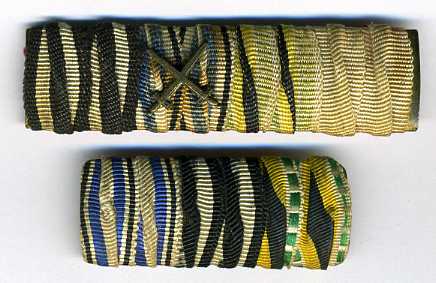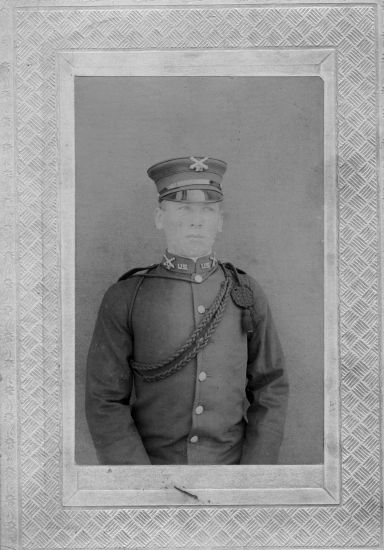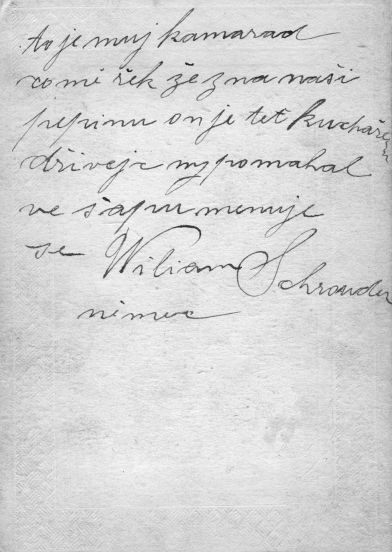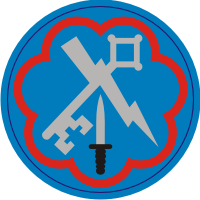-
Posts
489 -
Joined
-
Days Won
2
Content Type
Profiles
Forums
Blogs
Gallery
Events
Store
Posts posted by arb
-
-
Posted on behalf of Rick Research
One of the most commonly misunderstood aspects of researching anonymous Imperial German award groups is how rare COMBINATIONS of otherwise common awards actually were. Case in point, the prolific Great War numbers of Bavarian Military Merit Crosses (BMVKs with Xs) and Saxe-Meiningen War Merit Medals (SMM). With literally hundreds of thousands of the former (in the BMVK3X bronze classes) and almost 23,000 of the latter, neither of these awards could be considered rare.
Individually.
But how many SMMs were bestowed on NCOs, NCO-equivalent military officials, and privates in the Bavarian army?
A grand (drum roll please) total of 293.
None of those SMMs to Meininger “strays” in Bavarian uniform (as all were) went to Warrant Officers (Feldwebelleutnant and equivalent) who would have received a BMVK1X.
Possible recipients of a BMVK2X only numbered 55—and here is a pair of ribbon bars to one of them—

The 4 ribbon bar is in Prussian precedence (1920s) with dulled silver X device and faded Bavarian long service award in last place, while the lower bar (these came together from the same source) dates from during the war while in Bavarian uniform.
Divided by rank, these potential “silver X” rankers were
Wachtmeister-Offizierstellvertreter = 1 (listed as a regular)
Feldwebel = 4 (all listed as regulars, meaning all would have had a Jubilee Medal 1905 or 1911)
Wachtmeister = 7 (6 regulars—as above—and 1 dL probably no Jubilee Medal)
Vizefeldwebel-Offizierstellvertreter = 4 (3 listed as regulars—as above—and 1 dL—as above)
Vizewachtmeister-Offizierstellvertreter = 2 (1 a regular and 1 dR as noted above for Jubilee or not)
Unterzahlmeister = 3 (1 perhaps a regular but 2 listed with civilian occupations so NOT regulars)j
Vizefeldwebel = 21 (14 regulars, 3 dR, and 4 dL likely no Jubilees but regulars held long services)
Vizewachtmeister = 8 (5 regulars, 2 dR and 1 dL as noted above)
Offizierstellvertreter (without permanent NCO grade listed) = 4
Beamten-Stellvertreter = 1 (listed as a regular but this was a wartime temporary “generic” rank)
Of those 55, 17 had their SMMs gazetted in the Bavarian wartime issues of the Personal Nachrichten. One of the VWms can be removed as a suspect since he was later a Lt dR with no long service award. None of the others had any other “foreign” awards gazetted in the PN, leaving only class of BMVK to reduce potential suspects. The senior 18 NCOs above would either have had a Luitpold Jubilee Medal and a long service award or a long service award, based on whether regulars or Reserve or Landwehr—probably 11 with a 1905 or 1911 Jubilee and long service, so that many can be deducted as “suspects.”
238 junior NCOs and men who would have received one of the bronze BMVK3X classes (of whom 99 were gazetted in the PN), by rank were as follows—
Sergeant = 21
Unteroffizier = 70
Oberjäger = 2
Obergefreiter = 2
Gefreiter = 58
Privates in all branches of the Bavarian army = 85
Please bear in mind that of these 55 senior NCOs and 238 junior NCOs and privates, virtually every one who received ANY class of a Bavarian Military Merit Cross would have had that gazetted in the Personal Nachrichten, so pursuing each one of the 293 individually would result in further distinctions possible in BMVKs by classes with Swords and with or without Crown. (It has over 30 years since I’ve had access to the Personal Nachrichten—in the Library of the U.S. Congress, of all places!)
Here is a gigantic home-made ribbon bar from the Weimar Republic era, for a non-career junior NCO or private:

In Prussian precedence, this startling bar’s array of very ordinary common awards from states of the Empire with no apparent common service CAN be explained—
If the recipient was a member of K.B. Infanterie Regiment 8 ,,Großherzog Friedrich II. von Baden.” 216 members of that regiment had Baden awards gazetted in the wartime PNs. 35 of 60 Zähringen Lion Orders were gazetted, for some idea of the likely proportion of awards NOT gazetted.
After the war, its original wearer was back in “Prussian” territory, wearing his EK2 first. As a former-Bavarian, his BMVK3X came next (the gold swords must NEVER be taken to indicate a BMVK1X without proper context—gold swords devices were routinely used for correct bronze ones. These are of an oddball type only used on 1920s vanity veterans’ private purchase awards). Next his “hometown” SMM, then the otherwise “inexplicable” Baden Silver Merit Medal on MKFVO ribbon, and finally (he was a true warrior) a 1919-21 Silesian Eagle 2nd Class. So WAS this possible?
Indeed—
FIVE Meiningers (who received SMMs) strayed into the ranks of Bavarian Infantry Regiment 8—
One was a Vizefeldwebel-Offizierstellvertreter who can be excluded as a “silver X” grade NCO. The other 4 were
1) Gefreiter Karl Böttner of 3rd Company,
2) Gefreiter Friedrich Dreßler of 6th Company (gazetted in PN),
3) Gefreiter Artur Jakob of 9th Company (gazetted in PN), and
4) Unteroffizier dR Christian Kallenbach of 9th Company
It would be extraordinarily difficult to come up with any other “suspects” in the sort of miniscule specialist units (independent signals platoons, mountain mule sections etc) which had no “Inhaber” or territorial origin. It has always been a truism that the lower a soldier’s rank, the less likely he was/is to be decorated—especially lavishly.
By contrast, a mere 5 SMM holders were Meininger “strays” in Baden units (all of them in Ers Inf Rgt 28), 1 was a Badener in Meiningen’s own Inf Rgt 32, and 2 SMM recipients from Baden were in Saxon units.
So here we see “common” awards whose recipients can be, respectively, reduced to 1-of-44-or-less and probably-1-of-4… out of the entire Bavarian army!
It all comes down to having complete Rolls transcribed.
Source:
Award Roll of the Saxe-Meiningen War Merit Medal, transcribed by me
Potential sources for further research:
The Bavarian wartime ,,Personal Nachrichten,” and Ancestry-dot-com’s Bavarian infantry records online.
My thanks to Andy for posting this for me since I am not online. Rick Research
0 -
Although in German, this excerpt from a 1913 book used at the Prussian "Kriegschulen" clearly supports Glenn's explanation:
„Die Matrosen- und Werftdivisionen sind Mannschaftsdepots. Den Matrosendivisionen wird zur Besetzung der Schiffe das seemännische Personal, den Werftdivisionen das Maschinen-, Handwerker- und Verwaltungspersonal entnommen. Einen ähnlichen Zweck haben die Torpedodivisionen, die die Besatzungen der Torpedoboote und das Torpedopersonal der Schiffe stellen. Desgl. die Minenabteilung, Unterseebootsabteilung, Luftschiffabteilung und Fliegerabteilung.
Source: Leitfaden für den Unterricht über Heerwesen auf den Königlichen Kriegschulen.
Andy
0 -
Chip,
it has taken me the best part of six months to track down this guy's first name but perseverance pays off. Oberstleutnant Ludwig Schopp. Luckily for me, he was assigned to the Artillery Testing Commission in Berlin for a couple of years (1905-1906) whilst on the strength of Hohenzollernsches Fußartillerie-Regiment Nr. 13. Consequently he turned up in a Berlin address book of that year.
Regards
Glenn
Glenn,
Hat's off to you for digging this name up!
Andy
0 -
Andy, many thanks for this great additional info!

 I'm guessing there are no pictures of him? I took a quick look on Google and so far no luck. But definitely a bonus to have the signature of a holder of the PLM.
I'm guessing there are no pictures of him? I took a quick look on Google and so far no luck. But definitely a bonus to have the signature of a holder of the PLM. 
Dan

Dan,
The Biblio Series on the PLM winners does not, unfortunately, include a photo of von Heynitz, nor do I have a photo of him.
Andy
0 -
Dan,
You have a very nice grouping. The signature is that of Hans von Heynitz, commander of RIR 91 from 21.09.1914 until 20.08.1916. You'll be happy to hear that he was awarded the PLM on 03.12.1917. He was wounded on 30.11.1917 as commander of IR 92 (he was also serving simultaneously as the "Führer of 40. Inf. Brig.). He died of his wounds 09.12.1917.
Andy
0 -
This is a photograph of a United States soldier in the Coast Artillery Corps, circa 1910. I don't know the language of the writing on the back. Is it Czech?
Thanks,
Mark
Maryland


Yes, it's Czech. I can't make it all out, but it basically says "This is my friend who says he knows our ... He is now a cook....... and his name is William Schraeder." It's been over well over 25 years since I studied Czech, but I am confident this is a decent gist.
Andy
also in Maryland.
0 -
The unit looks like "Festungs Fernsprech Abteilung 3 Metz"
In 1914 there was a "Festungs Fernsprech Kompanie 3" in Metz, which must have been enlarged during the war.
Rough translation would be fortress telephone company, then battalion (Abteilung).
Andy
0 -
Greg,
Levin (Hermann Otto) von Düring was born 14.03.1769 and died 23.04.1836.
He joined the army on 09.08.1786, fought in the 1792/95 campaign against the French. In 1806 he was in Regiment Lettow (Nr. 41) and following the capitulation of Hameln he became inactive. Reactivated in Jan 1812 he transferred to the Gendarmerie in Feb 1813. In Aug 1813 he was promoted Major and made a battalion commander in the 1. Neumärkisches Landwehr Regiment. On 02.04.1815 he became commander of that regiment. On 05.06.1818 he became commander of Infantry Regiment 14 and served in that capacity until his retirement on 27.03.1831. He was promoted to colonel on 30.03.1821 When he retired, he was given the "Charakter" as a General Major.
He was awarded the EK II for his actions in the Battle of Dennewitz.
Priesdorf's series on the Prussian Generals (Soldatisches Führertum) contains the biography and image of von Düring I used to provide this short career sketch. If you are interested in the biography and/or image of von Düring, please send me a private message with your e-mail address and I'll be happy to scan and send it to you.
Andy
0 -
I've combed through my resources but can't come up with this officer. Do you have any additional information which might assist int he search? Rank, date of rank, anything else???
Andy
0 -
Greg,
There is one Oberstleutnant von Düring listed in the 1817 Prussian Army List. He is shown as the commander of the 1. Neumärksches Landwehr Regiment. Do you have any additional information or can you place this man in context which might enable me to trace him through the Army lists from 1817 forward or perhaps even back to 1806???
Andy
0 -
Which officer are you looking for? If he was in the army in 1914, I might be able to assist.
Andy
0 -
James,
I just sent you an e-mail at the address given on your site.
Andy
0 -
James,
I have access to the Militär Wochenblatt for 1905 which contain casualty lists and would be happy to provide them if they would assist in your efforts.
Andy
0 -
Chip,
Unfortuinately, I can't give you a first name, but there was a Fußart. Hptm. Schopp in FußAR 18 at the beginning of the war. The 1926 Ehrenrangliste shows his last wartime assignment was as commander of the 3. Garde FußAR, so, I think this is your man. As we all know, first names are rather hard to come by, especially for non-infantry or cavalry officers.
Andy
0 -
Vince,
Paul Weinland was born 27.02.1861 in Friedrichshafen in Württemberg. He joined the württ. FAR 13 in 1881. In 1893 he transfered to the prussian army. He was the Art. Offiz. v. Platz (AOvP) in Cüstrin from 1896-1899, then he was in FußAR 9. In 1901 he went to FußAR 13, 1906 to FußAR 2, 1908 to FußAR 11, 1909 to FußAR 9. He became Vorst. d. Art. Depots in Posen on 18.04.1913.
I have no record of him as the AOvP in Marienburg- what leads you to that assignment??
Ken,
The Vorstände der Art. Depots are listed in the 1914 Rangliste in the section for "Gouvernements, Kommandanturen und Garnisonen". You'll find him on page 133 of the 1914 Rangliste.
Andy
0 -
Claudio,
Here is Kraemer's career up to 1914
Karl Kraemer (12.07.1861-)
21.02.11-1914 Ing. Offiz. v. Platz i. Metz O, v. 4. Ing. Insp.
27.01.07-21.02.11 Mitgl. d. Ing. Komm., U.d. 3. Ing. Insp.
(1906)-27.01.07 k.z. Dienstl. b. Ing. Komm., v. 3. Ing. Insp.
1905-1906 z. Fortif. Dienst i. Straßburg v. 3. Ing. Insp.
1901-1904 Lehr. a.d. Kr. Sch. i. Engers, U.d. Pion. B. 16
1898-1900 Chef 4./Pion. B. 16 (Metz)
18.07.96-1897 in 4./Pion. B. 16 (Metz)
14.09.93-18.07.96 Adj. b. 2. Ing. Insp. (Berlin) v. 2. Ing. Insp.
1892-14.09.93 Adj. d. 3. Fest. Insp. (Posen) v. 2. Ing. Insp.
1889-1891 z. Fortif. Dienst i. Posen v. 2. Ing. Insp.
1886-1888 in 1./Pion. B. 16 (Metz)
1884-1885 k.z. Art. u. Ing. Sch. v. 3. Ing. Insp.
1883 in 2./Pion. B. 14 (Kehl)
Oberstlt. 22-03-14 N
Major 27-01-08 G2g
Hptm. 27-01-97 D6d1
Oblt. 18-03-92
Leutn. 13-09-82
Orden 1914
PRAO4 PDK BMV4mKr
Andy
0 -
John,
You are quite welcome. Glad to have helped.
Andy
0 -
Here is a list of all 16- taken from the 1868 Ordensliste. This is from my database, so, apologies for the lack of formatting. Read name, rank, unit, souce (1868 Ordenmsliste page 637) and the action for which the award was made.
Andy
Bäßler, Friedrich Musketier IR 72 1868 Ordensliste-637 Königgrätz
Bochnia, Gottlieb Füsilier 1. GRzF 1868 Ordensliste-637 Königinhof
Buchwald, Carl Ulan UR 1 1868 Ordensliste-637 Nachod
Duchale, Adolph Trompeter DR 8 1868 Ordensliste-637 Nachod
Flauder, Otto Sergeant UR 1 1868 Ordensliste-637 Nachod
Foerster, Carl Sergeant IR 46 1868 Ordensliste-637 Schweinschädel
Görlitz, Franz Gefr. IR 67 1868 Ordensliste-637 Königgrätz
Hoebald, Wilhelm Musketier IR 67 1868 Ordensliste-637 Königgrätz
Mersiowski, August Unteroff. IR 46 1868 Ordensliste-637 Schweinschädel
Müller, Gustav Unteroff. IR 72 1868 Ordensliste-637 Königgrätz
Reudelsdorff, Ferdinand Unteroff. DR 8 1868 Ordensliste-637 Nachod
Sattler, Ernst Gefr. DR 8 1868 Ordensliste-637 Nachod
Schellin, Heinrich Füsilier 1. GRzF 1868 Ordensliste-637 Königgrätz
Seichter, August Feldw. IR 13 1868 Ordensliste-637 Aschaffenburg
Woltner, Carl Unteroff. IR 55 1868 Ordensliste-637 Kissingen
Wurfschmidt, Wilhelm Gefr. HR 10 1868 Ordensliste-637 Königgrätz
0 -
August von Werder 04.03.1871
From the Baden Staats Anzeiger.
Andy
0 -
Gunnar,
There was an Oblt. Möschke in IR 117 at the beginning of the war. His name was Erwin Möschke (born 03.07.1879) and he was promoted Hptm. on 05.09.1914. He survived the war, but I have no idea what assignments he had as the Ehrenrangliste shows only that he ended the war as a Major a.D.
Andy
0 -
Gunnar,
His first name was Erich and he was born 20.06.1876
Andy
0 -
The Rittmeister I mentioned previously in this thread, Georg, and whom Luc agreed was not the man he was searching for, had three sons. They were Gert (*28.05.1894), a Fähnrich in Dragoner R. 16 in 1914, Jürgen (*09.06.1899) and Hans-Dietrich (*27.07.1902). So, absent any confirmation, a case could easily be made that the very fine cap pictured in this thread belonged to Gert given his regimental affilition (he is also to be found in the Ehrenrangliste on page 421 in Dragoner R. 16).
However, it's always tricky to decide an item belonged to a certain individual solely on circumstantial evidence, no matter how tempting it might be to claim to have identified an owner. I for one would be wary of stating a connection exists. Nevertheless, I think Gert is a strong candidate as the owner.
I used the 1914 "Gothaisches Genealogisches Taschenbuch der Freiherrlichen Häuser" as my source.
Andy
0 -
Luc,
From 22.07.00-18.12.03 he was commander of the 5th squadron of Husaren R. 11 (Düsseldorf). From 18.12.03-1905 he was commander of the 5th squadron of Kürassier R. 4 (Münster). He retired sometime between Jun 1905 and April 1906.
The 1905 Army List shows his only awards to be the PRAO4 and PStJO.
Andy
0 -
Bernard Gr. Finck von Finckenstein (1863-1945)
13.09.19 als char. Gen.Lt. d. Absch. bew.
1919 Chef d. Jaeger u. Schuetzen, Chef d. Reit. Jaeger K.
1918-1919 Kom. d. 2. GIB
1917-1918 Kom. d. 4. Garde Inf. Div.
1914-1917 Kom. d. 2. GIB
1914 Fuehr. d. 2. Garde Inf. Brig. (GIB)
1913-1914 Kom. d. GGR 1
Andy
0




When Are “Common” Groups Researchable? SMMs to Bavarians
in Germany: Imperial: The Orders, Decorations and Medals of The Imperial German States
Posted · Edited by arb
If you are able to find the correct picture, I will provide the information to Rick, who will be happy for the additional information.
Andy